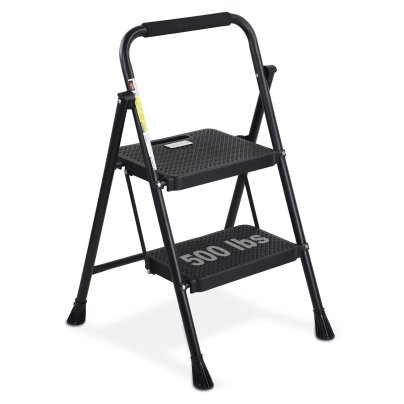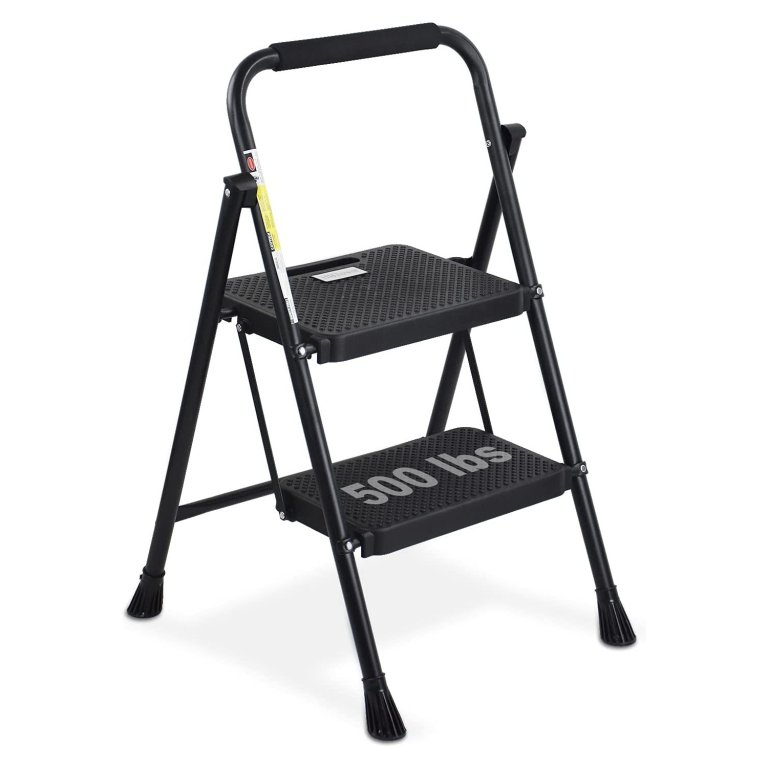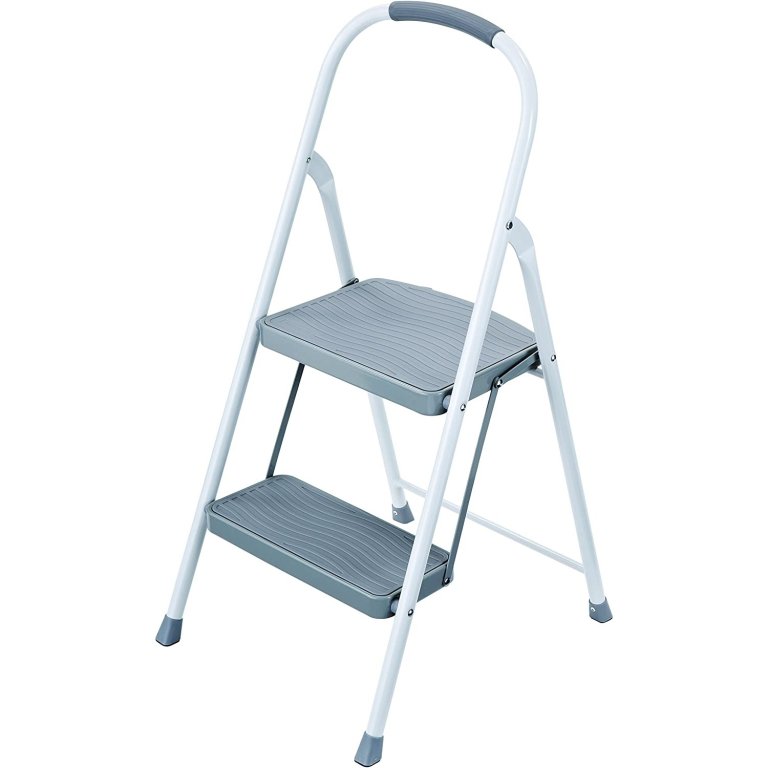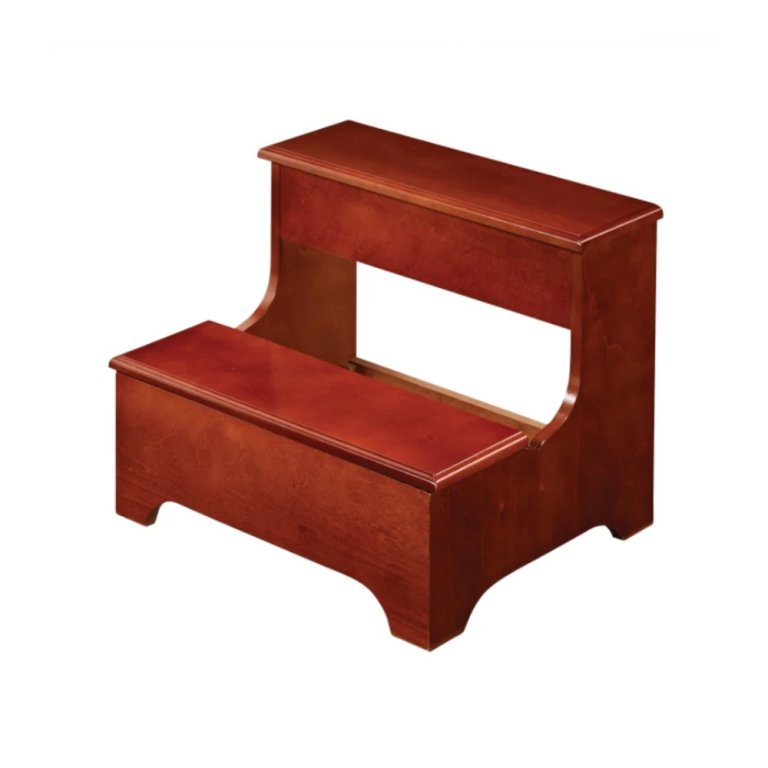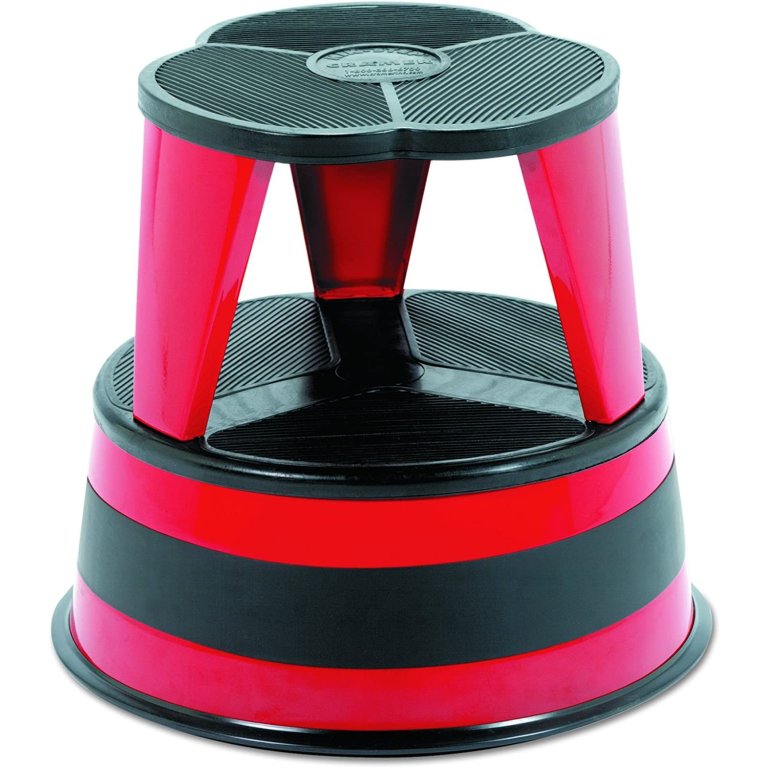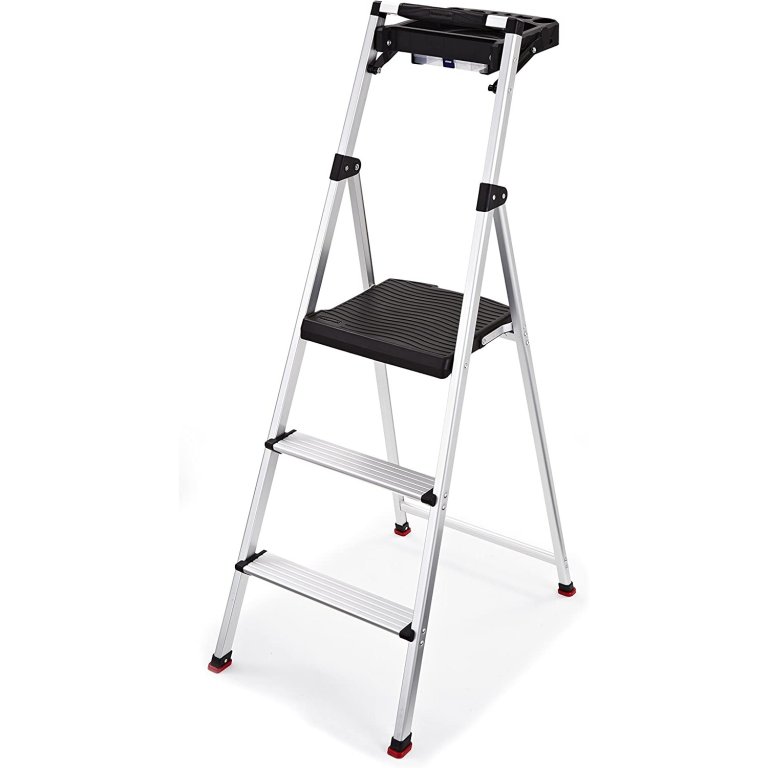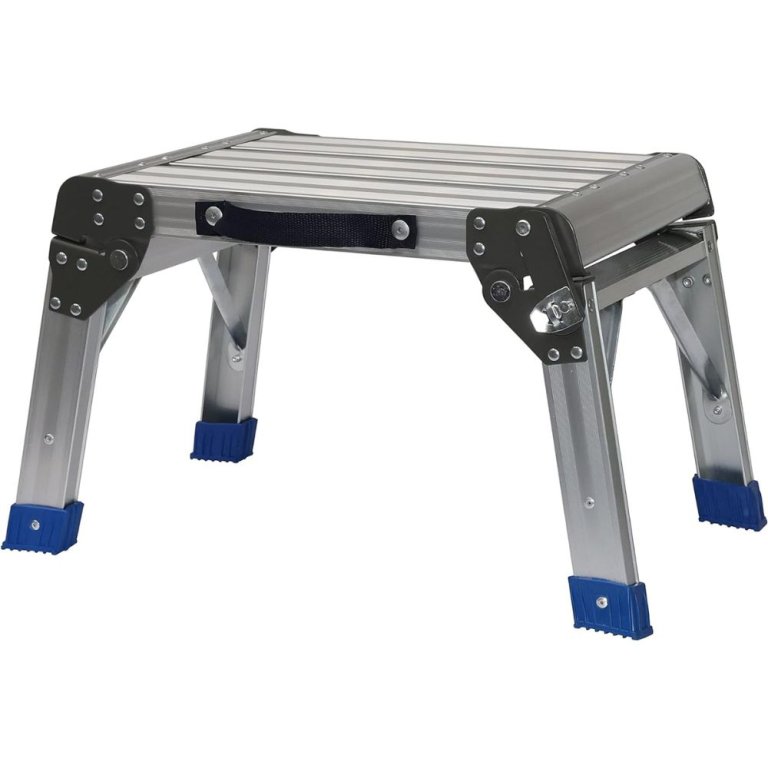
We may earn revenue from the products available on this page and participate in affiliate programs. Learn More ›
Step stools are handy for almost any task that involves reaching up high, from accessing the top cabinet in the kitchen to installing a new shelf on the wall. A must-have item in many homes, a step stool is a worthwhile buy from the get-go.
The best step stools are safe and dependable, so potential buyers can expect years of use around the house. They’ll support your weight and feel sturdy underfoot—and some even look stylish while doing so. We wanted to see how well today’s step stools are made, so we decided to use them ourselves. Keep reading to discover the key features to consider when shopping and learn how each of the following models performed in our hands-on testing.
- BEST OVERALL: HBTower 2-Step Folding Ladder
- BEST BANG FOR THE BUCK: Rubbermaid 2-Step Steel Step Stool
- BEST DESIGN: Red Barrel Studio Ottman 2-Step Wood Step Stool
- BEST THREE-STEP: Little Giant Ladders 3-Step Jumbo Step Stool
- BEST HEAVY-DUTY: Cramer Kik-Step Steel Step Stool
- BEST WITH TRAY: Rubbermaid 3-Step Aluminum Stool With Project Tray
- BEST PLATFORM: MaxWorks Foldable Aluminum Platform Step Stool
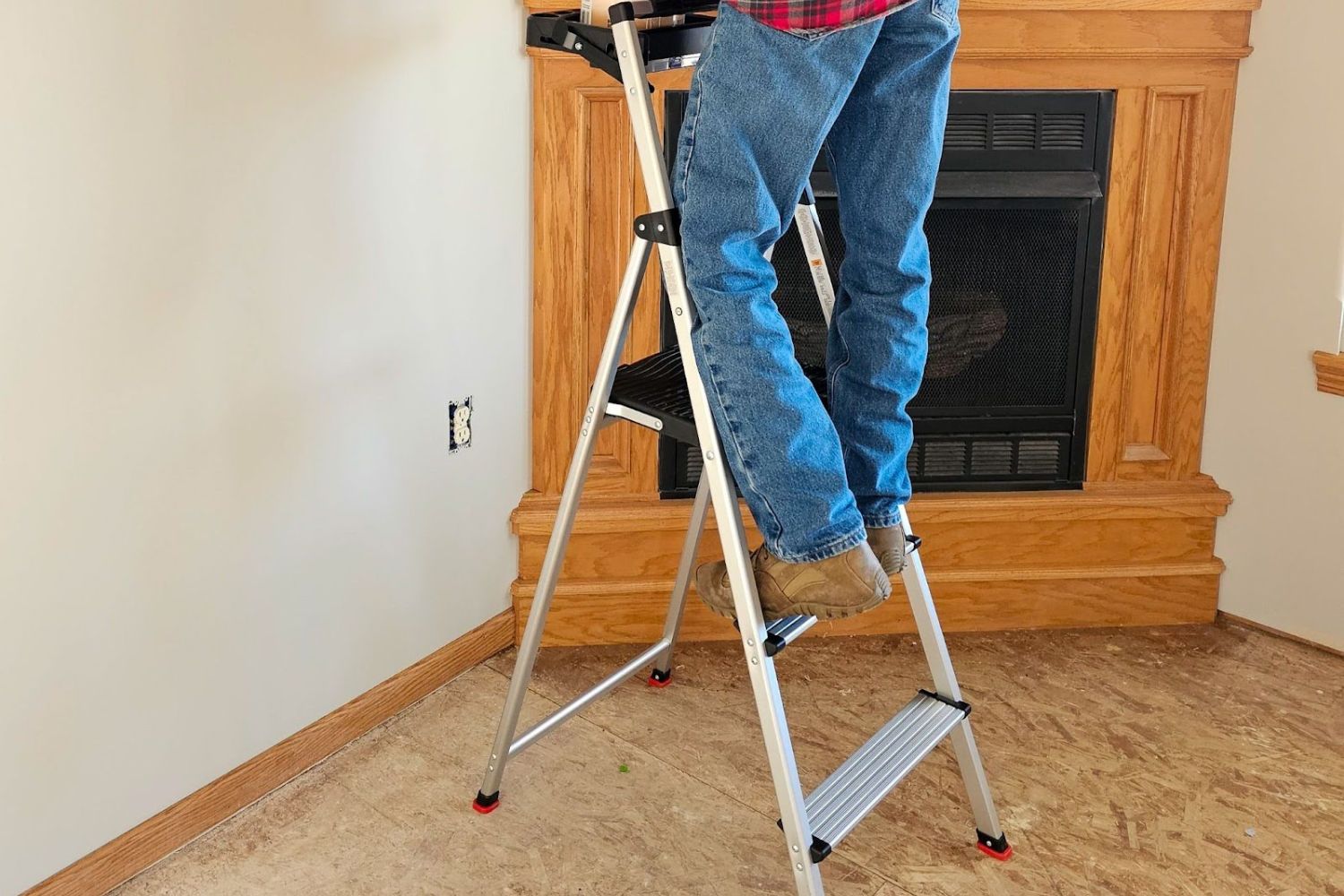
How We Tested the Best Step Stools
Step stools are not complicated accessories, but quality and safety can vary from model to model. We carefully researched almost three dozen step stools, with a focus on high customer satisfaction, ease of use, safety features like locking mechanisms, and quality materials. We also looked for step stools in a variety of categories and price ranges. After researching all of these models, we chose a select few to test in our own homes for various climbing needs.
In our testing of the step stools, we confirmed all the features, noted how easy or difficult they were to open and close, and paid attention to any other perks or flaws. We climbed on them, carried them around, stuck them in closets, and even jumped on them to test their sturdiness.
During the testing process, we awarded points based on a rubric. The better a step stool did on a test, the more points it received. After testing, we averaged the points and noted where each model excelled to help determine its best use. Our testing was stringent—not every step stool we tried out earned a spot in this guide of the best step stools.
Our Top Picks
To make our list of the best step stools, each of the following models had to demonstrate sturdiness and come with safety and user-friendly features that make it easier to gain a bit of extra height around the home. One of these step stools may be the perfect find for you.
Best Overall
HBTower 2-Step Folding Ladder
Pros
- Automatic locking mechanism keeps the step stool from collapsing when in use
- Ideal for household tasks that require reaching overhead, like hanging pictures
- Padded grip on the handle and anti-slip feet make it easy to use and secure
Cons
- Plastic step treads could be slightly slippery when wet
Product Specs
- Frame material: Alloy steel, metal
- Height (top step): 18.7 inches
- Weight capacity: 500 pounds
The HBTower step stool offers several safety and convenience features, making it an excellent step stool for many homes. With an impressively high weight limit of 500 pounds, this model can easily support most users, plus their tools. Its strength comes from the alloy-steel frame, paired with large rubber-padded feet to keep it safely in place and prevent damage to flooring.
We found the HBTower step stool easy to carry at 9.24 pounds, and we liked the padded top rail grip that was soft to the touch. Plus, we appreciated the padding when we fetched this step stool from the bitterly cold garage for testing—it kept us from having to grab the cold metal.
This two-step stool measures 18.7 inches tall to the top step, which is just about right for most household tasks. We stood on the stool, leaned to the sides, and even jumped, and it held firm. The step treads feature a texture that helps reduce slipping, but the surface is made from molded plastic. We would have preferred rubber treads for additional slip prevention if we needed to use the step stool in wet conditions.
When the job is finished, this step stool folds almost flat to 1.6 inches deep—it slid easily into the narrow space beside our fridge. This is a solid, well-made step stool that should last for years.
Read our full review: HBTower 2-Step Folding Ladder
Get the HBTower step stool at Amazon, Walmart, or Kmart.
Best Bang For The Buck
Rubbermaid 2-Step Steel Step Stool
Pros
- Lightweight and easy to carry
- Nonslip and nonmarring feet offer added security and protect flooring
- Locks into place when open and folds easily via a small latch
Cons
- Not designed for tasks that require leaning to 1 side—tends to tip
Product Specs
- Frame material: Steel
- Height (top step): 18 inches
- Weight capacity: 225 pounds
The Rubbermaid 2-Step Stool was another winner in our tests; best of all, it comes at an affordable price point. Manufactured from sleek tube steel, this step stool is smooth to the touch, and it’s actually kind of attractive, whereas many step stools offer a strictly utilitarian look.
Featuring a metal step stool frame, this model combines sturdiness, ease of use, and portability. It weighs 10.5 pounds, and we found it simple to carry. The top rail features a nonslip rubber grip for extra security when stepping up and down, and the nonslip rubber feet didn’t shift or slip, even on slick flooring. The step stool locks in the open position for safety during use. It’s also easy to fold—simply press a little latch on the back side of the top step.
The large textured steps provided secure footing, and the oversize top step allowed us to stand comfortably with both feet and turn from side to side without any wobbling. It supports up to 225 pounds, which isn’t as much as some of the other step stools we tested, but we found it held our weight easily. This step stool was also not as secure when we leaned to the sides as some of the other models. We could lean a little, but it started to tip if we leaned too far. Solution? Don’t lean on a step stool: Get off the stool, move it over, and then get back on for added safety.
This is a versatile climbing companion that could serve as a kitchen step stool or in the bathroom and other areas of the home. While this step stool is not designed for heavy-duty use, we found it more than suitable for most everyday tasks.
Get the Rubbermaid two-step step stool at Amazon or Walmart.
Best Design
Red Barrel Studio Ottman 2-Step Wood Step Stool
Pros
- Relatively high weight capacity of up to 375 pounds
- Solid-wood craftsmanship with a high-quality finish makes it a stylish addition to a room
- Well suited for use in many types of rooms, including bedrooms, home libraries, and more
Cons
- Lacks a handle for support; standing at the front edge of the top step may lead to tipping
- Not suitable for outdoor use or in wet environments
Product Specs
- Frame material: Wood
- Height (top step): 15 inches
- Weight capacity: 375 pounds
Get a leg up in style with the Red Barrel Studio Ottman wood step stool. Unlike traditional step stools that prioritize utility over aesthetics, this two-step stool is an attractive addition to any room. It would be welcome in a bedroom next to a bed with a tall mattress or in a home library with overhead shelves. We tested this model in various indoor spots—but it’s not made for outdoor use.
One of the standout features of the Red Barrel Studio step stool is the selection of colors from which shoppers can choose. We found the oak finish blended very well with our oak trim, but other finishes are also available, including chestnut, cherry, and driftwood.
With a substantial 375-pound weight limit and a top step height of 15 inches, this step stool is for more than just looks—we found it very stable when stepping on the lower step. It features small pads on the bottom that reduce sliding on slick floors and keep the stool from marring the floor.
While the step stool is undeniably well-made and stable, it’s essential to use caution when standing on the top step. The design lacks a handle or a mechanism to keep it from tipping forward, so we felt safest when we placed it next to a cabinet or wall to prevent tipping. It’s also a good idea to use just the bottom step. This model would likely not be the best toddler step stool based on its propensity for tipping.
Get the Red Barrel Studio step stool at Wayfair.
Best Three-Step
Little Giant Ladders 3-Step Jumbo Step Stool
Pros
- Broad design makes it feel more like a staircase than a step stool
- Outward sloped leg design provides stability and prevents wobbling
- Adjustable safety handrail can be used in either a raised or lowered position
Cons
- On the bulky side for indoor storage, potentially limiting its convenience for some users
Product Specs
- Frame material: Aluminum
- Height (top step): 26 inches
- Weight capacity: 375 pounds
This three-step Little Giant Ladders step stool is an excellent option for those who need a good amount of height in a small package, such as DIYers or on-the-job users. This aluminum
has three wide steps, and the top step is 26 inches high.
Unlike the other step stools we tested, the Little Giant Ladders stool has a broad design that feels more like a staircase; it was easy to climb up the steps even with our hands full of tools and paint cans. The large platform steps feature a nonslip surface, and the broad leg design provides stability and support. The step stool didn’t wobble or threaten to tip as we climbed, jumped, and leaned to the sides.
This model can be used with or without the safety handrail—the rail is easy to raise and lower to suit the specific task. We preferred the rail in the raised position because it has an integrated tool tray that holds small tools. When the job is complete, this stool folds flat for storage, although we found it to be a bit bulky for storing in an indoor closet; it’s probably better suited to storing in a garage, storage shed, or basement.
The Little Giant Ladders step stool exceeds Occupational Safety and Health Administration (OSHA) and American National Standards Institute standards and has an impressive 375-pound weight limit.
Get the Little Giant Ladders step stool at Amazon, Lowe’s, Walmart, or Little Giant Ladders.
Best Heavy-Duty
Cramer Kik-Step Steel Step Stool
Pros
- Sturdy steel construction and scratch-resistant powder coating provide durability and longevity
- Rolling design allows the stool to be pushed along with a foot and then stepped on when in position
- Wraparound bumpers protect nearby walls and furniture as well as the stool itself
Cons
- Not a step stool with handle access, so users will want to be confident in their ability to use it without additional support
- Using the roll-and-step design is a bit of a learning curve and may take some getting used to
Product Specs
- Frame material: Steel
- Height (top step): 14.5 inches
- Weight capacity: 350 pounds
The Cramer Kik-Step steel step stool is immediately recognizable for its distinctive round shape and rolling design. Users can push this heavy-duty step stoolalong with a foot and then step on when it’s in the right position. Shoppers who haven’t used one of these step stools before will want to know that it takes a little getting used to, but many users note that once they got the hang of it, they found this stool to be indispensable for tasks or projects that require frequently stepping up in different spots.
This model is made of solid steel with a scratch-resistant powder coating and is available in a variety of colors. Wraparound bumpers protect nearby walls and furniture—as well as the stool itself—from damage. It doesn’t come with a handle, so users will want to be confident in their ability to step up and down without holding on to something for support.
The design is simple but ingenious—spring-mounted castor wheels on the underside of the stool allow it to roll easily until weight—up to 350 pounds—is exerted on the top of the stool. When that happens, the upper part of the stool lowers to the floor, providing a sturdy base on which to stand or sit.
The step stool arrived in two sections, and assembly was a simple matter of snapping them together. Since this stool doesn’t fold like many step stools on the market, it will need storage space at least as large as its widest point—14.5 inches. While that means the stool may be harder to store, it has no folding parts that can wobble or snap. For frequent users, this rolling step stool is a good option to leave out rather than tuck away since it’s on retractable castors, making it easy to move when necessary.
Get the Cramer step stool at Amazon, Wayfair, or Walmart.
Best With Tray
Rubbermaid 3-Step Aluminum Stool With Project Tray
Pros
- Features a project tray for home renovations and DIY projects
- Durable, lightweight aluminum provides balance, sturdiness, and portability
- Nonmarring rubber feet prevent the stool from slipping on hard floors
- Ideal for homes with higher-than-average ceiling heights
Cons
- Not suitable for leaning to 1 side or the other
- Weight capacity is only 225 pounds, potentially making it less sturdy for some users
Product Specs
- Frame material: Aluminum
- Height (top step): 29 inches
- Weight capacity: 225 pounds
As the second Rubbermaid step stool to make our top picks, this 3-step stool serves as a transition between a lower stool and a step ladder, making it well suited for tasks that require a bit more height without the need—or bulk—of a larger ladder. This model also features a project tray that is ideal for home renovation projects.
The top step comes in at 29 inches, and it’s more of a platform than a step: We were able to stand, jump, and turn around on it confidently. We tested this step stool for various uses and found it excellent for painting overhead. While this is a sturdy step stool for most uses, it tended to tip if we leaned too far to either side. But leaning is a no-no on most step stools and
, so this isn’t a deal-breaker.
The step stool is made from durable, lightweight aluminum and weighs just 9 pounds, so it’s easy to carry from job to job. Despite being lightweight, it has a weight capacity of 225 pounds. Rubber nonmarring feet keep it stable on various flooring types, and when the job is complete, the stool folds flat for storage. This Rubbermaid model would be an excellent choice in homes with ceilings higher than the traditional 8 feet.
Get the Rubbermaidthree-step step stoolat Amazon, The Home Depot, or Walmart.
Best Platform
MaxWorks Foldable Aluminum Platform Step Stool
Pros
- Features robust aluminum construction with an anodized finish for durability
- Capable of supporting an impressive 350-pound capacity
- Lightweight design makes it simple to carry to jobsites or other locations
- Includes a convenient carry handle for added ease of use
Cons
- Absence of a support handle may limit use for those who need added hand support
- Top step height of only 8 inches may limit its use for tasks requiring more elevation
Product Specs
- Frame material: Aluminum
- Height (top step): 8 inches
- Weight capacity: 350 pounds
This folding step stool proved to be a sturdy assistant in our tests. While the MaxWorks platform step stool lacks a handle, it remains a reliable choice for painting, drywall taping, and other tasks around the home or jobsite. The platform features extruded aluminum construction and a durable anodized finish for longevity and sturdiness. The impressive load capacity of 350 pounds makes it suitable for most users.
With a top step height of 8 inches, this small step stoolissuitable for several just-out-of-reach needs, such as hanging pictures and painting at the top of standard 8-foot walls.
The thoughtful design incorporates folding legs and a built-in carry strap for easy transport and compact storage—we could easily fit it in our truck tool box. This model weighs a mere 3.5 pounds, so carrying it from spot to spot is a cinch.
Nonmarring rubber feet on each leg keep it from slipping on hard, slick floors. The platform size of 18 inches long by 12 inches wide provides a spacious working area, and it didn’t wobble even when we jumped on it. While the lack of a handle requires users to be confident in stepping up, this lightweight and durable step stool is an excellent option for various settings, including homes, garages, workshops, and offices.
Get the MaxWorks step stool at Amazon.
Or, DIY Your Own Step Stool
Making your own step stool is a relatively straightforward project for an eager DIYer with some basic tools. When building a step stool, the easiest material to use is wood—either new or scrap wood that’s in good condition.
Several free, straightforward DIY wooden step stool guides appear online that even beginners can tackle. Many DIY step stool plans use wooden planks that users can pick up from a hardware store to create simple one-step or two-step stools.
Apart from the wood, some tools that a DIYer will likely need to build a step stool include a miter saw, a drill, screws, a jigsaw, and a Kreg jig, as well as measuring and marking tools to ensure all the cut pieces fit together. Don’t forget the safety protection like safety glasses and ear plugs.
The advantages of making a wooden step stool are that you can stain or paint it to your liking and also add helpful features, like metal or rope carrying handles.
Jump to Our Top Picks
What to Consider When Choosing a Step Stool
Step stools are useful for everyday tasks, as well as for decorating, organizing, or renovating. While a step stool is a simple item, a variety of factors go into choosing a suitable option. Potential buyers can narrow down the best step stool for their needs by considering its materials, height, weight limit, portability, and any additional safety and user-friendly features.
Material and Usage
The most common step stool materials are plastic, wood, and metal. Each material has its benefits and drawbacks in terms of design, durability, and usage.
- Plastic: High-quality plastic is a sturdy, lightweight material that comes in a variety of designs and colors. Its versatility and durability make this an excellent material for step stools. Plastic step stools often have a textured nonslip finish and are shaped into a variety of designs. They are also waterproof and won’t rust—a stellar choice for wet areas. However, low-quality plastic can become brittle and crack, so look for a plastic step stool from a reputable brand.
- Wood: Wood is a classic strong material often used to make stylish step stools. Since wood is a natural material, shoppers typically choose a wooden step stool for its aesthetic or sturdiness, or for sustainability reasons. Wooden step stools are on the heavier side and usually come in basic designs. While wood is long lasting, it’s not the best material for wet environments because unsealed wood can mold or rot.
- Metal: The most common metals used to make step stools are aluminum and stainless steel. Both materials are frequently corrosion- and rust-resistant, although plastic is still often the best option for wet areas. Aluminum typically is lighter than steel. Regardless of the type of metal step stool, look for nonslip rubberized feet to prevent slipping and floor damage.
Height
Step stools boost users to access hard-to-reach spots, but the amount of extra height varies by model. Step-stool heights range from around 1 to 4 feet, usually measured to the top step. Step stools are available in one-, two-, and three-step designs.
Consider the intended use of the step stool when choosing a height. A kids’ step stool with a shorter height could be suitable to help them reach the bathroom sink, while a taller step stool might be necessary for home improvement tasks. Plenty of in-between sizes also are available, which are ideal for all-purpose tasks, such as reaching the top of a kitchen shelf or changing a light bulb.
Weight Limit
Step stools have a weight limit—the maximum amount of weight the step stool can safely hold—which generally ranges from 250 to 300 pounds. Some step stools for kids have a lower weight limit, while heavy-duty step stools could have a weight limit that exceeds 300 or even 500 pounds.
Ensure the step stool has a high enough weight limit to support anyone who will use it. It’s also important to factor in the weight of tools or other items that users may be holding while on the stool. If a step stool breaks while in use (especially taller two-step or three-step stools), it creates the potential for serious injury. Therefore, it’s often better to choose a ladder with a higher weight limit.
Portability and Storage
If looking for a portable step stool, consider a foldable design. A foldable option is not only portable, but it also can store more easily. Some stools fold flat, all the way to about 2 inches thick. Foldable step stools come in several height options, from one-step stools that tuck beside a bathroom counter to three-step stools that hang from a hook in a workroom.
Lightweight step stools are more portable than their heavier counterparts, so consider lighter materials like plastic or aluminum. Integrated carrying handles make it easier to carry a step stool from room to room.
Additional Features
Step stools often include additional safety and convenience features to make them safer and easier to use. The most common safety feature is a textured or rubberized nonslip surface.
Nonslip feet are a must in wet areas—they’ll keep the step stool in place and also prevent damage to the floor. A grippy nonslip step surface is a prudent choice, although it can make the stool less stylish in appearance.
A larger collapsible step stool often includes locking latches to help keep it stable in the unfolded position. Handrails, extra-wide steps, and built-in project trays also improve safety and convenience.
Step stools don’t have to be stored; instead, today’s attractive, modern step stools can do double duty by being displayed or used as a small side table or storage shelving and then cleared when needed for their intended purpose.
FAQs
Step stools are handy to have around the house for everyday tasks. But if you’re a first-time buyer—or just haven’t given them much thought—you may have a few more questions. Read on for answers to some frequently asked questions about choosing and using a step stool.
Q. How do I pick a step stool?
Consider the intended use, weight limit, and sturdiness of the step stool to narrow down your options. The right step stool provides a sturdy step, supports your weight, and is tall enough to allow you to reach whatever you need.
Q. What is the maximum height of a step stool?
According to OSHA guidelines, a step stool should not exceed 32 inches in height. For bigger jobs, it’s best to be safe and invest in one of the best full-size ladders.
Q. Can I stand on top of a step stool?
It depends on the step stool design and height. Short step stools are designed for users to stand on the top step. On taller step stools and step ladders, the highest safe step is indicated, so don’t stand higher than that step.
Q. Are step stools considered ladders?
Generally, one-step or two-step step stools are considered step stools. Step stools with three or more steps are often considered step ladders; however, some blurring exists between the categories. For those looking for a taller option, we also reviewed the best step ladders.
Meet the Tester
Glenda Taylor is a product tester and writer specializing in the construction, remodeling, and real estate industries. She and her husband own a general contracting company, and Taylor is experienced in both residential and commercial building applications. She tests a wide range of power tools as well as other home improvement, household, and lawn-and-garden products.
Additional research provided by Jasmine Harding.
